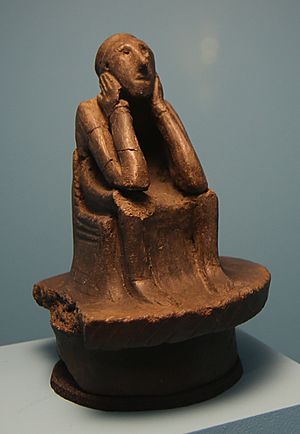Spong Hill facts for kids
Quick facts for kids Spong Hill |
|
|---|---|
| Lua error in Module:Location_map at line 420: attempt to index field 'wikibase' (a nil value). | |
| Location | Norfolk, England |
Spong Hill is a very important Anglo-Saxon burial ground in Norfolk, England. It's the biggest early Anglo-Saxon cemetery ever found!
This site has two main parts. There's a large cemetery where people were cremated (their bodies burned). There's also a smaller cemetery from the 6th century with 57 burials where bodies were buried whole (inhumations). Some of these graves were covered by small mounds of earth called barrows. Others were marked with coffins.
Archaeologists have dug up a lot of the early Saxon cemetery. They also found signs of people living on the hill even before the Anglo-Saxons. This includes evidence from the Mesolithic (Middle Stone Age) and early Bronze Age.
When digging up the Anglo-Saxon cemetery, they also found older things. These included Iron Age and Roman enclosures and field boundaries. They even found an early Roman kiln (a type of oven). There was also a small settlement with 'sunken huts' and post-hole buildings. These might have been used around the same time as the cemetery.
Contents
What Was Spong Hill Used For?
Spong Hill holds the remains of 2,259 cremations and 57 inhumations. It was used for about 150 years. During this time, between 2,500 and 3,000 people were buried there.
This suggests the cemetery served a population of about 750 people. That's much larger than a single village from that time. This means the cemetery was likely used by several local communities.
Discovering Spong Hill
People first reported finding cremation urns at Spong Hill in 1711. There was a small dig in the 1950s. More investigations happened in 1968.
The biggest excavation took place from 1972 to 1981. Dr. Catherine Hills led this huge project. The Department of the Environment helped pay for the work.
Cool Finds at Spong Hill
The Spong Man

The "Spong Man" is a special pottery lid from a cremation urn. It's shaped like a person sitting down. It was found in 1979.
This lid is very unique for early Saxon archaeology. It's the oldest Anglo-Saxon 3D human figure ever discovered! The lid is about 14 centimeters (about 5.5 inches) tall.
The Spong Man was shown at a big exhibition called "Anglo-Saxon Kingdoms: Art, Word, War." This was at the British Library in 2018 and 2019.
Urns with Special Symbols
Three cremation urns from the 5th century were found at Spong Hill. These urns have a special symbol pressed into them. It's a runic symbol that looks like "alu." The same stamp was used on all three urns, but it was pressed in a mirrored way.

